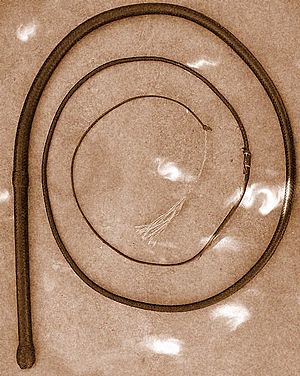Bullwhip facts for kids

A bullwhip
|
|
| Types | Whip, pastoral, hand tool |
|---|---|
| Used with | Livestock |
A bullwhip is a special type of whip. It has a single tail and is usually made from braided leather or strong nylon. People use bullwhips as tools to help manage livestock like cows. They are also used in competitions.
Bullwhips are traditional tools for people who work with animals in open fields. They are long, flexible, and get thinner towards the end. This design allows them to be thrown in a way that makes part of the whip move faster than the speed of sound. When this happens, it creates a small "crack" sound, which is actually a tiny sonic boom! It's important to know that bullwhips were rarely used to hit animals. Hitting them could cause harm.
A bullwhip is different from a stockwhip. Stockwhips are also used for livestock, especially in Australia. But they have a slightly different design.
Contents
The History of Bullwhips
It's hard to know exactly when and where bullwhips first appeared. Leather doesn't last forever, so old whips are rarely found. Also, different names for whips in various places make it tricky to track their history.
Some people think the bullwhip was created in South America. Others believe it came there from Spain. However, ancient Roman art from around 200-300 AD shows whips that look very similar to modern bullwhips. This suggests that whips with a tapered design were used a very long time ago.
As farms and ranches started using more machines in the late 1800s and early 1900s, fewer people needed whips. Making bullwhips became a dying skill. By the mid-1900s, only a few skilled craftspeople were left.
But in the late 1900s, interest in old crafts grew again. Movies like Raiders of the Lost Ark also helped. The hero, Indiana Jones, used a bullwhip as a tool and a weapon. This made many people interested in whip cracking as a hobby and a sport. Today, whip cracking competitions focus on cool tricks and hitting targets accurately.
In the past, bullwhips had one main purpose. Now, whip makers design them for different uses and throwing styles. But all bullwhips share some basic parts.
Parts of a Bullwhip
A bullwhip has four main parts: a handle, a thong, a fall, and a cracker. Sometimes there's also a loop on the handle for hanging the whip.
The Thong
The longest part of the bullwhip is called the thong. It's made by braiding many strips of leather or nylon. The more braids, the better the whip usually is. Good quality whips often have inner layers called "bellies." These are also braided leather. Cheaper whips might not have bellies or might be stuffed with other materials. The thong connects directly to the handle.
The Handle
The handle is usually short, about 8 to 12 inches (20 to 30 cm) long. Some handles are plain wood, while others are covered in braided leather or nylon. Leather handles often have a thicker end called a butt foundation. This fits nicely in your hand. Nylon handles might have a special knot at the end. Some handles can swivel, which helps with certain tricks.
Whips are measured from the end of the handle to the end of the braided thong. Bullwhips can be from 3 feet (0.9 m) to 20 feet (6 m) long, or even longer!
The Fall
The fall is a single piece of leather or nylon cord. It's about 10 to 30 inches (25 to 75 cm) long. The fall is designed to be replaced easily. This is because it takes a lot of stress when the whip is cracked. In cheaper whips, the fall might just be a continuation of the thong, which means it can't be replaced.
The Cracker
At the very end of the fall is a flexible piece called the cracker or popper. This is the part that helps make the loud "crack" sound. Even without a cracker, a whip can make a sonic boom, but the cracker helps spread the sound so you can hear it better. Crackers wear out quickly and need to be replaced often. They can be made from horsehair, string, nylon, or other materials.
Bullwhips come in many different weights and designs. Some light whips have weights inside for better balance. While leather is traditional, nylon whips are now popular. They were first used in wet places like Florida because nylon is easier to care for than leather. Nylon whips are also often less expensive.
Kangaroo leather is a favorite for whip makers. It's much stronger than cowhide. This allows for more detailed braiding patterns.
Bullwhips for Hunting
Some people have used bullwhips for hunting. Simon Tookoome, an Inuit expert from Canada, was known for using his bullwhip to hunt. He hunted small birds like ptarmigans and larger animals like caribou. He even used it to kill a wolf he had shot and injured. He kept his whip with him because using a rifle was too expensive.


